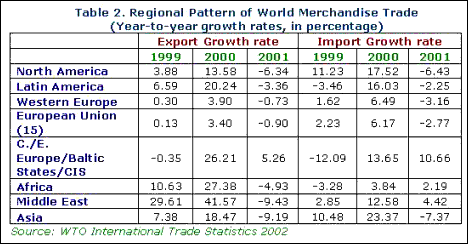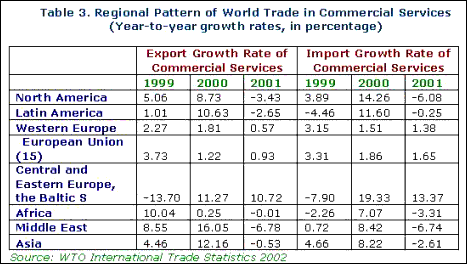The 2002 edition of the
annual publication of WTO titled "International Trade Statistics"
has been recently released. This report shows a dismal picture of international
trade in 2001[1]. On a year-to-year basis, the dollar
value of world merchandise exports decreased by 4.5 per cent in 2001 and
the value of commercial services contracted by 0.5 percent. According
to this report, after 1982, this is only the first time when world trade
has registered a negative growth rate.
The figures released by WTO reveal that all sectors of merchandise trade
performed poorly during the year 2001. The only major product group which
recorded an increase in its export value was chemicals. Manufactured exports
slumped by 2.5 percent, while agricultural exports were down from the
previous year by 0.9 percent. However, the biggest decline is recorded
in the exports of office and telecommunications equipment, which registered
a decline of more than 18 percent in 2001 (Table 1). The overall slump
in the information technology sector, steep decline in economic activity
in the major developed country markets and the upheaval following the
terrorist attacks of September 11 contributed to this outcome.
 |
| In 2001, merchandise trade of all seven major geographic regions recorded substantially lower growth than in the previous year. More significantly, in all regions except the transition economies, export and import values contracted (Table 2). Among the big trading countries, only China managed to maintain its growth rate in international trade and became the fourth largest trader after the United States, the European Union and Japan in 2001. |
 |
Along with merchandise trade, world commercial services trade also stagnated in 2001. After recording an expansion of 6 per cent in 2000, world trade in commercial services declined by 0.5 percent in 2001. The deceleration in world services trade touched every major region and was particularly strong in North America, Africa and Asia (Table 3). |
 |
 |
However, an interesting pattern
of trade has emerged in 2001. The 'Overview' section of the WTO report
points out that intra-developing country trade has performed relatively
better in this year vis-à-vis trade with other regions. As a result,
for the third consecutive year, the share of intra-trade in developing
countries' exports has increased (Figure 1). For agricultural and mining
products, South-South trade has reached an all time peak level (39 per
cent and 41 per cent respectively) in 2001. The share in manufactures
exports was (35 per cent), however, is lower in 2001 than in 1993.
To explain the poor trade performance of 2001, the International Trade
Statistics Report has blamed the overall recessionary trend in the global
economy and the disturbances that followed the terrorist attack on September
11 of that year. However, it is also possible that other factors have
played their part in this stagnation. Research reports[2]
have repeatedly pointed out that considerable trade barrier still exists
in developed countries for commodities in which developing countries have
export interest. For example, textiles and agriculture remain the most
protected sectors in the markets of developed countries. Developing countries
account for some 50 percent of world textile exports and 70 percent of
world clothing exports. It is likely that the backloading of quota removal
by Canada, the EU, and the United States is hurting the trade prospects
of these countries.
Secondly, in agriculture, the developed countries have managed to retain
prohibitively high tariffs, high domestic and export subsidies in various
forms. This has severely limited the prospects of trade growth of the
developing countries. Moreover, the AoA does not require the developed
countries to undertake any reduction till the new agreement is implemented.
Therefore no new market access is expected in the intervening period.
Continued presence of high protection in the developed country markets
in key areas is probably a reason why the growth of international trade
has stagnated in the recent years. This also explains why intra-developing
country trade is increasing at a faster pace. Addressing these issues
is important for the recovery of global trade.
However, from the speech made by the Director-General of WTO after the
release of the International Trade Statistics, it seems that instead of
correcting these imbalances, WTO is depending heavily on the progress
of the Doha Development Agenda to pull the global economy out of the current
slump in international trade. Director-General of WTO Supachai Panitchpakdi
said:
"The disappointing trade figures for 2001 and the first half of 2002
underscore the importance of making progress in the Doha Development Agenda
negotiations. While the depressed levels for imports and exports reflect
macroeconomic factors, it is evident that policy measures must be taken
to bolster confidence and provide the underlying assurances necessary
to foster higher levels of growth. One such measure would be for political
leaders to send a strong signal to consumers, producers and markets that
they intend to move forward in the area of further trade liberalization
through the DDA.".
But reports seem to indicate that the progress of Doha Development Agenda
(DDA) has hit a roadblock. The Economist points out that the recent protectionist
measures adopted by the US and EU has cast a shadow of doubt on the success
of the DDA[3]. As a result, more and more countries are
using the Regional Trade Agreements (RTAs) to look for increased market
access. This is not only making WTO less relevant in the global economic
scenario but is also putting a serious question mark on WTO's attempt
to solve this problem of stagnation only through the DDA. If the concerns
of developing countries are not addressed, it is unlikely that with continued
sluggish growth in most of the developed world, international trade will
recover in near future.